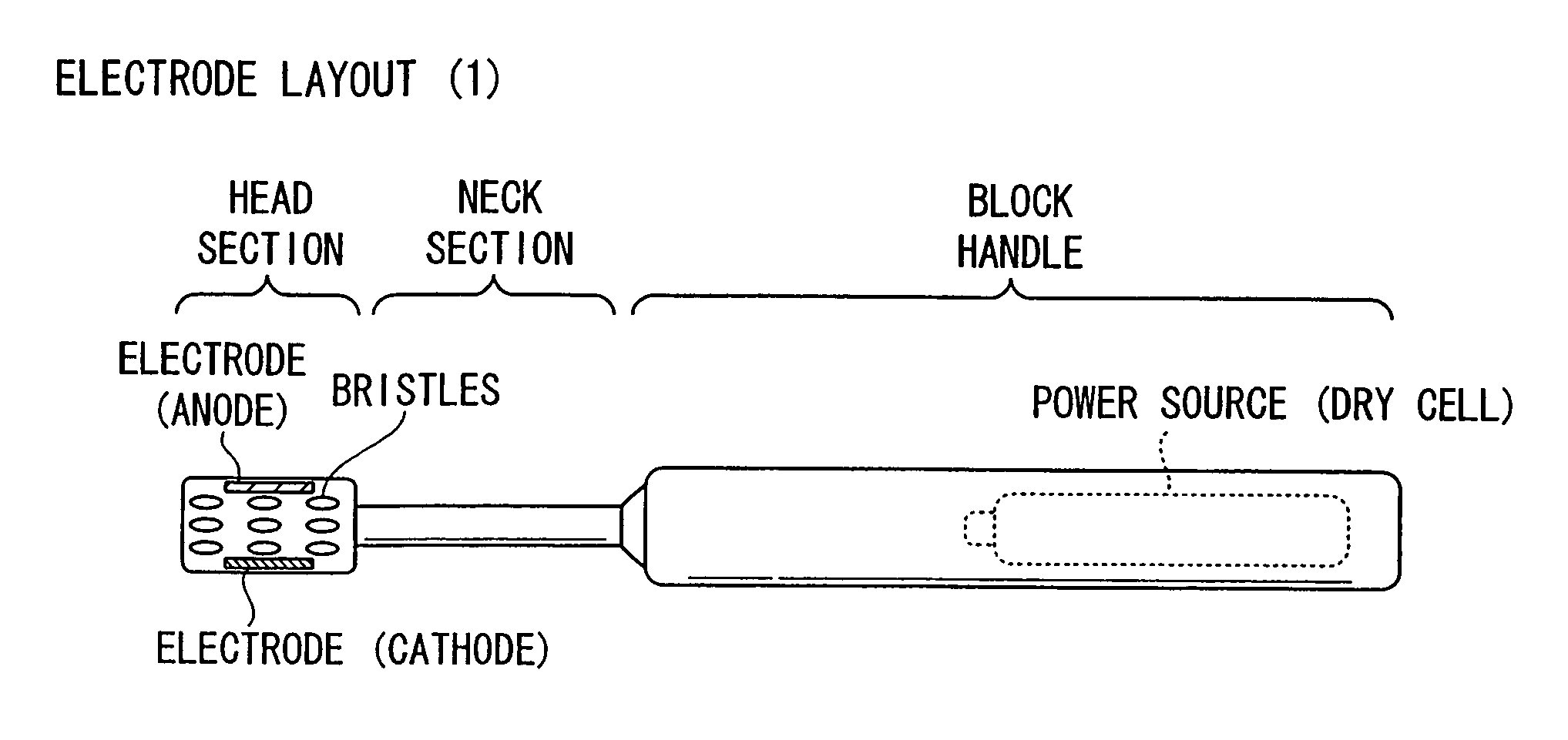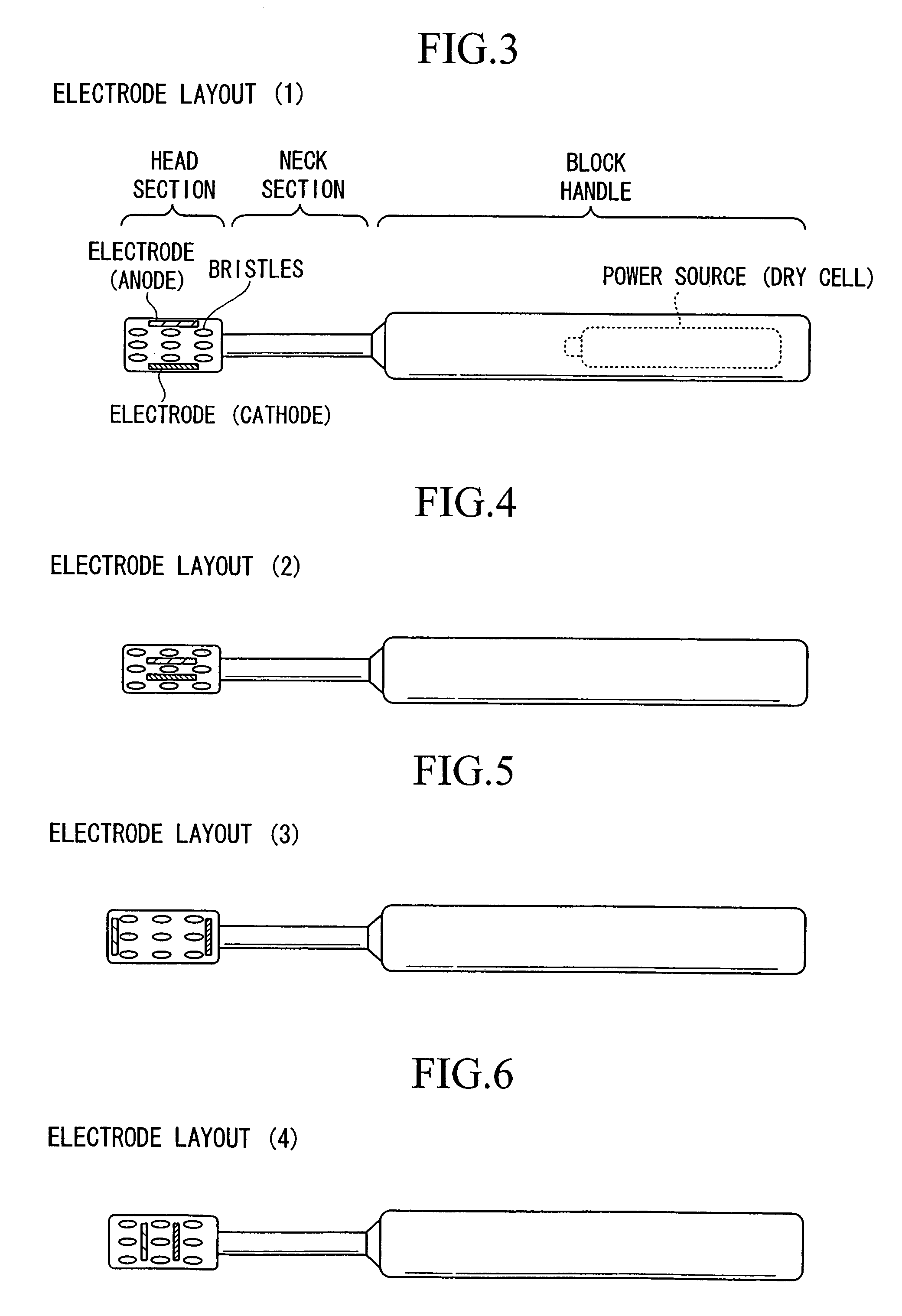Oral cavity cleaning tool
a cleaning tool and oral cavity technology, applied in the field of oral cavity cleaning tools, can solve the problems of difficult to achieve the sterilization effect, large and complex apparatus, and inability to carry out sterilization inside the oral cavity by means of a single tool, and achieve the effect of low operating voltage, efficient sterilization, and convenient us
- Summary
- Abstract
- Description
- Claims
- Application Information
AI Technical Summary
Benefits of technology
Problems solved by technology
Method used
Image
Examples
experiment 1
[0057]The present applicant verified the characteristics of the oral cavity cleaning tool of the present invention, with the oral cavity cleaning tool of the present invention shown in FIG. 1 being prepared. The first electrode and the second electrode were made of platinum, and were disposed at a space selected within a range from 0 mm to 20 mm from each other. The block handle was made of polypropylene resin (PP). Power was supplied from a button cell with voltage of 3 V or 4.5 V. Oral fluid shown in the table was used.
[0058]Sterilization effect was verified using the oral cavity cleaning tool described above, by evaluating the effect of sterilizing the oral bacteria S. mutans. Sterilized physiological saline was used as the oral fluid to control the concentration of the oral bacteria to 106 cfu / ml. 2 ml of the liquid with the controlled concentration of bacteria was transferred to a multi-well plate, and the oral cavity cleaning tool was applied thereto and electric current was c...
experiment 2
[0063]Value in use of a toothbrush, to which the oral cavity cleaning tool of the present invention was applied, was evaluated. The toothbrush according to the present invention shown in FIG. 2 was prepared. The toothbrush has the same constitution as that of No. 3 in Experiment 1, except for planting brushing bristles in the head section. The first electrode and the second electrode were made of platinum, and were disposed at a space of 10 mm and 15 mm from each other. The block handle was made of polypropylene resin (PP). Power was supplied from a button cell with voltage of 3 V. The toothbrush of No. 3 with the power switch turned off was used as a comparative example (No. 1).
[0064]Value in use of the toothbrushes was evaluated by 30 panelists. The panelists' evaluation of the value in use upon brushing teeth for 3 minutes is shown in Table 3. Result of free answer evaluation is shown in Table 4. In Table 3, A shows evaluation of excellent, B shows good, C shows inability to deci...
experiment 3
Comparison with Commercialized Toothbrush
[0068]Generation of effective chlorine was evaluated using commercialized toothbrushes.
[0069]PM Brush and Soladey (both brand names) were used as the commercialized toothbrush. The PM Brush has two different metals embedded in the head section. Accordingly, the head section of the PM Brush was cut off and the rest of it was placed vertically at the bottom of a test tube having capacity of 15 ml over which 2 ml of physiological saline was poured. It was confirmed that the metallic members were completely submerged in the physiological saline. After leaving the sample to stand still in the physiological saline for 3 minutes, concentration of effective chlorine in 2 ml of physiological saline was measured, using SIBATA weak acidity electrolytic water kit.
[0070]Soladey is activated when the semiconductor provided in the neck section is wetted with water. Accordingly, the plug-in head section was removed and the neck section of the semiconductor w...
PUM
 Login to View More
Login to View More Abstract
Description
Claims
Application Information
 Login to View More
Login to View More - R&D
- Intellectual Property
- Life Sciences
- Materials
- Tech Scout
- Unparalleled Data Quality
- Higher Quality Content
- 60% Fewer Hallucinations
Browse by: Latest US Patents, China's latest patents, Technical Efficacy Thesaurus, Application Domain, Technology Topic, Popular Technical Reports.
© 2025 PatSnap. All rights reserved.Legal|Privacy policy|Modern Slavery Act Transparency Statement|Sitemap|About US| Contact US: help@patsnap.com



